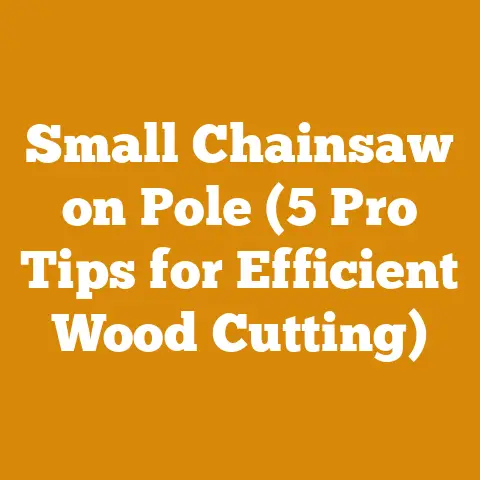Homebuilt Stump Grinder Tips (5 Pro Arborist Tricks)
How to Build a Stump Grinder: 5 Pro Arborist Tricks for the DIY Enthusiast
Okay, let’s talk stump grinders. I’ve spent years in the arboriculture industry, both professionally and tinkering in my own backyard. And let me tell you, those lingering stumps after a tree removal can be a real pain. Hiring a professional stump grinding service isn’t always feasible, especially for smaller jobs or if you’re on a tight budget. That’s where the allure of a homebuilt stump grinder comes in.
Now, let’s be clear: building a stump grinder isn’t a walk in the park. It involves power tools, metal fabrication, and a healthy dose of mechanical know-how. But with the right approach, some ingenuity, and a commitment to safety, you can build a functional and cost-effective stump grinder. The “5 Pro Arborist Tricks” I’m going to share aren’t just about the build itself; they’re about understanding the principles that make stump grinders effective and safe.
1. Understanding the Stump Grinder’s Core: The Cutting Wheel Design
The heart of any stump grinder is the cutting wheel. It’s what actually interacts with the stump, turning that stubborn wood into manageable chips. The design of this wheel, and especially the teeth, is crucial for performance and longevity.
Key Concepts:
-
Cutting Teeth: These are the replaceable components that do the actual grinding. They are typically made of hardened steel or carbide-tipped for increased durability.
-
Wheel Diameter: A larger diameter wheel provides a greater cutting arc, allowing you to grind a wider area in a single pass. However, larger wheels also require more power.
-
Wheel Speed (RPM): Higher RPM generally translates to faster cutting, but it also increases wear and tear on the teeth and the engine.
-
Tooth Arrangement: The arrangement of the teeth on the wheel affects the aggressiveness of the cut and the size of the chips produced.
The Pro Trick: Don’t reinvent the wheel (pun intended!). Look at commercially available stump grinder wheels. Analyze their design. Notice the angle of the teeth, the spacing between them, and the overall shape of the wheel. This will give you a solid starting point for your own design.
Example: I once tried to build a stump grinder with a cutting wheel that had teeth that were too aggressively angled. It bogged down the engine and produced very large, uneven chips. After studying commercial designs, I realized the importance of a more gradual cutting angle, which allowed the engine to maintain its RPM and produced finer, more consistent chips.
Step-by-Step Guide:
-
Research: Study the designs of commercial stump grinder wheels. Pay attention to the tooth arrangement, angle, and material. Look at models from brands like Vermeer, Rayco, and Bandit. These are industry leaders, and their designs are well-proven.
-
Material Selection: For the wheel itself, use a high-strength steel plate (e.g., A36 steel, at least 1/2″ thick). This will ensure the wheel can withstand the stresses of grinding.
-
Tooth Design: Consider using readily available, replaceable carbide-tipped teeth. These are more expensive upfront but will last much longer than steel teeth. Look for teeth that are specifically designed for stump grinders.
-
Tooth Attachment: Weld the teeth securely to the wheel. Use a welding process appropriate for the steel type (e.g., MIG or TIG welding). Ensure the welds are strong and free of defects.
-
Balancing: Once the teeth are attached, balance the wheel dynamically. This is crucial to prevent vibration and premature wear on the bearings and engine. You can take the wheel to a machine shop for balancing.
Measurements & Specifications:
-
Wheel Diameter: 12-18 inches is a good starting point for a homebuilt stump grinder.
-
Tooth Angle: Experiment with angles between 15 and 30 degrees.
-
Tooth Material: Carbide-tipped is highly recommended.
-
Wheel Thickness: At least 1/2″ steel plate.
-
RPM: Target an RPM range of 2000-3000 RPM, depending on the engine size and wheel diameter.
Case Study: A friend of mine, a retired machinist, built a stump grinder using a wheel he fabricated himself. He meticulously copied the tooth design from a Vermeer stump grinder, using carbide-tipped teeth he sourced online. The result was a surprisingly effective machine that rivaled some commercial models in terms of performance.
2. Powering Your Grinder: Engine Selection and Mounting
The engine is the powerhouse of your stump grinder. Choosing the right engine is critical for ensuring sufficient power and reliability.
Key Concepts:
-
Horsepower (HP): This determines the engine’s ability to deliver torque, which is essential for grinding through tough wood.
-
Engine Type: Gasoline engines are the most common for stump grinders, but diesel engines offer better fuel efficiency and longevity.
-
Engine Mounting: The engine must be securely mounted to the frame of the stump grinder to prevent vibration and movement.
The Pro Trick: Don’t underestimate the power you’ll need. Stumps, especially those from hardwood trees like oak or maple, can be incredibly dense. A minimum of 13 horsepower is recommended, and more is always better. Overpowering is better than underpowering.
Example: I once tried to use a small 8 horsepower engine on a stump grinder. It struggled to cut through even relatively small stumps. Upgrading to a 15 horsepower engine made a world of difference.
Step-by-Step Guide:
-
Engine Selection: Choose a gasoline engine with a minimum of 13 horsepower. Look for engines with a horizontal shaft and a standard mounting pattern. Brands like Honda, Kohler, and Briggs & Stratton are known for their reliability.
-
Engine Mounting Plate: Fabricate a sturdy mounting plate from steel. The plate should be thick enough to prevent flexing and vibration. Drill holes in the plate to match the engine’s mounting pattern.
-
Vibration Dampening: Use rubber vibration isolators between the engine and the mounting plate. This will help reduce vibration and noise.
-
Belt Drive System: Connect the engine to the cutting wheel using a belt drive system. Use high-quality V-belts and pulleys that are properly sized for the engine’s horsepower and the desired wheel RPM. Ensure the belt alignment is perfect to prevent premature wear.
-
Tensioning System: Incorporate a belt tensioning system that allows you to adjust the tension on the belts. This is important for maintaining optimal performance and preventing belt slippage.
Measurements & Specifications:
-
Engine Horsepower: 13 HP minimum, 15-20 HP recommended.
-
Belt Type: High-quality V-belts (e.g., B-section or C-section).
-
Pulley Ratio: Calculate the pulley ratio to achieve the desired wheel RPM.
-
Mounting Plate Thickness: At least 1/4″ steel plate.
Case Study: One of my colleagues built a stump grinder using a salvaged 18 horsepower Briggs & Stratton engine from an old riding lawnmower. He fabricated a custom mounting plate and belt drive system. The machine was surprisingly powerful and reliable, proving that you can often save money by using salvaged parts.
3. Building a Robust Frame: Strength and Stability
The frame of your stump grinder is the foundation that supports all the other components. It needs to be strong, stable, and able to withstand the stresses of grinding.
Key Concepts:
-
Steel Tubing: Square or rectangular steel tubing is commonly used for building frames.
-
Welding: Strong, clean welds are essential for ensuring the frame’s integrity.
-
Weight Distribution: Proper weight distribution is crucial for stability and maneuverability.
The Pro Trick: Overbuild the frame. It’s better to have a frame that’s too strong than one that’s too weak. The vibrations and forces generated during stump grinding can be significant, and a weak frame will eventually fail.
Example: I once saw a homebuilt stump grinder with a flimsy frame made from thin-walled tubing. It vibrated excessively and eventually cracked at the welds.
Step-by-Step Guide:
-
Design: Create a detailed design of the frame, including dimensions and material specifications. Use a CAD program or even just a pencil and paper.
-
Material Selection: Use square or rectangular steel tubing with a wall thickness of at least 1/8″. For critical areas, consider using thicker tubing.
-
Cutting: Cut the steel tubing to the required lengths using a chop saw or angle grinder.
-
Welding: Weld the tubing together to form the frame. Use a welding process appropriate for the steel type (e.g., MIG or TIG welding). Ensure the welds are strong and free of defects.
-
Reinforcement: Add gussets and bracing to critical areas of the frame to increase strength and rigidity.
-
Wheel Mounting: Incorporate a sturdy mounting point for the cutting wheel assembly. This should be designed to withstand the forces generated during grinding.
-
Handle and Controls: Add a handle for maneuvering the stump grinder and mounting points for the engine controls.
Measurements & Specifications:
-
Steel Tubing Size: 2″ x 2″ or 2″ x 4″ square or rectangular tubing.
-
Wall Thickness: At least 1/8″.
-
Welding Process: MIG or TIG welding.
-
Gusset Material: 1/4″ steel plate.
Case Study: A local metal fabricator I know built a stump grinder frame using heavy-duty steel tubing and meticulous welding. He also incorporated a unique suspension system that helped absorb vibrations. The result was a very durable and comfortable machine to operate.
4. Control and Maneuverability: Steering and Depth Adjustment
A stump grinder needs to be easy to control and maneuver, allowing you to grind the stump accurately and efficiently.
Key Concepts:
-
Steering: The ability to easily move the stump grinder around the stump.
-
Depth Adjustment: The ability to control the depth of the cut.
-
Ergonomics: The design of the handles and controls should be comfortable and easy to use.
The Pro Trick: Think about how you’ll be using the stump grinder. Will you be working on flat ground or uneven terrain? Will you be grinding large stumps or small ones? This will influence the design of your steering and depth adjustment mechanisms.
Example: I built a stump grinder with a fixed axle and no steering. It was incredibly difficult to maneuver around stumps, especially on uneven ground.
Step-by-Step Guide:
-
Steering Mechanism: Consider using a pivoting axle or a set of caster wheels to provide steering. A simple pivoting axle can be fabricated from steel tubing and bearings. Caster wheels offer good maneuverability on smooth surfaces.
-
Depth Adjustment: Design a system for adjusting the height of the cutting wheel. This can be achieved using a threaded rod and nut, a hydraulic cylinder, or a simple lever system.
-
Handle Design: Design the handle to be comfortable and ergonomic. Consider using rubber grips to reduce vibration.
-
Control Placement: Position the engine controls (throttle, kill switch) within easy reach of the operator.
-
Safety Features: Incorporate safety features such as a shield to protect the operator from flying debris and a kill switch that can be easily activated in an emergency.
Measurements & Specifications:
-
Axle Diameter: At least 1″ steel axle.
-
Caster Wheel Diameter: 4-6 inches.
-
Threaded Rod Diameter: 1/2″ or 3/4″.
-
Handle Height: Adjust the handle height to suit the operator’s height.
Case Study: One of my neighbors, a retired engineer, built a stump grinder with a sophisticated hydraulic depth adjustment system. He used a small hydraulic cylinder and a hand pump to precisely control the height of the cutting wheel. This allowed him to grind stumps with great accuracy.
5. Safety First: Guards, Shields, and Personal Protective Equipment
Stump grinding is inherently dangerous. Flying debris, rotating machinery, and sharp cutting teeth pose significant risks. Safety must be your top priority.
Key Concepts:
-
Guards: Protective covers that prevent contact with moving parts.
-
Shields: Barriers that protect the operator from flying debris.
-
Personal Protective Equipment (PPE): Equipment worn by the operator to protect against hazards.
The Pro Trick: Don’t cut corners on safety. Invest in high-quality PPE and build robust guards and shields for your stump grinder.
Example: I once saw a stump grinder with no guards or shields. The operator was showered with flying debris and narrowly avoided serious injury.
Step-by-Step Guide:
-
Cutting Wheel Guard: Fabricate a sturdy guard that completely encloses the cutting wheel. The guard should be made of thick steel and securely attached to the frame.
-
Debris Shield: Install a shield behind the cutting wheel to protect the operator from flying debris. The shield should be made of a durable material such as steel or polycarbonate.
-
Belt Guard: Enclose the belt drive system with a guard to prevent accidental contact with the moving belts and pulleys.
-
Personal Protective Equipment: Always wear the following PPE when operating a stump grinder:
- Eye Protection: Safety glasses or a face shield.
- Hearing Protection: Earplugs or earmuffs.
- Gloves: Heavy-duty work gloves.
- Long Pants and Long Sleeves: To protect against flying debris.
- Steel-Toed Boots: To protect your feet.
-
Emergency Stop: Install an easily accessible emergency stop switch that can quickly shut down the engine.
Measurements & Specifications:
-
Guard Material: At least 1/8″ steel plate.
-
Shield Material: Steel or polycarbonate.
-
PPE: Use ANSI-approved safety glasses, earplugs, and steel-toed boots.
Additional Tips and Considerations:
- Welding Skills: If you’re not comfortable welding, consider hiring a professional welder to fabricate the frame and other critical components.
- Metal Fabrication Tools: You’ll need access to a variety of metal fabrication tools, including a chop saw, angle grinder, welding machine, and drill press.
- Parts Sourcing: Source parts from reputable suppliers. Don’t be tempted to use cheap, low-quality components.
- Testing: Before using your stump grinder on a real stump, test it thoroughly in a safe environment.
- Maintenance: Regularly inspect and maintain your stump grinder. Keep the cutting teeth sharp, lubricate the bearings, and check the belts for wear.
- Local Regulations: Check your local regulations regarding the use of stump grinders. Some areas may have restrictions on noise levels or operating hours.
- Green Wood vs. Seasoned Wood: Green wood refers to freshly cut wood with high moisture content. It’s generally easier to grind than seasoned wood, which has been dried and is much harder. Adjust your grinding technique accordingly. For green wood, you might need to remove the chips more frequently, while for seasoned wood, you might need to make multiple passes.
- Wood Type Selection: Different wood types have varying densities and hardness. Pine, for example, is relatively soft and easy to grind, while oak and maple are much harder. Be prepared to adjust your grinding technique and the sharpness of your teeth based on the wood type.
- Firewood Stacking: While not directly related to stump grinding, proper firewood stacking can help accelerate the drying process, making the wood easier to process for other purposes. Stack the wood in a single row, off the ground, and in a sunny, well-ventilated location.
- Drying Methods: Air drying is the most common method for drying firewood. It typically takes 6-12 months for wood to dry sufficiently. Kiln drying is a faster method, but it’s more expensive.
- Moisture Content Targets: For firewood, the target moisture content is 20% or less. You can use a moisture meter to check the moisture content of the wood.
Strategic Advantages of a Homebuilt Stump Grinder:
- Cost Savings: Building your own stump grinder can save you a significant amount of money compared to buying a commercial model.
- Customization: You can customize your stump grinder to meet your specific needs and preferences.
- Learning Experience: Building a stump grinder is a great way to learn about mechanical engineering and metal fabrication.
- Self-Reliance: You’ll be able to grind stumps whenever you need to, without having to rely on a professional service.
Challenges Faced by Global DIYers and Small-Scale Logging Businesses:
- Access to Tools and Materials: In some parts of the world, it can be difficult to access the tools and materials needed to build a stump grinder.
- Technical Expertise: Building a stump grinder requires a certain level of technical expertise.
- Safety Concerns: Stump grinding is a dangerous activity, and it’s important to take all necessary safety precautions.
- Cost of Parts: The cost of parts can be a significant barrier for some DIYers and small-scale logging businesses.
Next Steps:
- Research and Planning: Thoroughly research stump grinder designs and plan your build carefully.
- Gather Tools and Materials: Collect all the necessary tools and materials.
- Fabrication: Start fabricating the frame and other components.
- Assembly: Assemble the stump grinder, paying close attention to detail.
- Testing and Refinement: Test the stump grinder thoroughly and make any necessary refinements.
- Safety Training: Get proper safety training before using the stump grinder.
Building a stump grinder is a challenging but rewarding project. By following these pro arborist tricks and taking all necessary safety precautions, you can build a functional and cost-effective machine that will help you tackle those stubborn stumps. Remember, safety always comes first! Good luck, and happy grinding!






